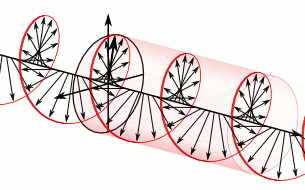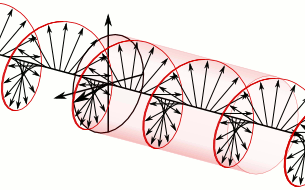User:Dave3457/Sandbox/Left right handedness
Left/right handedness conventions [edit]


Circular polarization may be referred to as right-handed or left-handed, depending on the direction in which the electric field vector rotates. Unfortunately, two opposing historical conventions exist. In physics, astronomy, and optics, polarization is defined as seen from the receiver, such as a optical or radio telescope.[1] Using this convention, left or right handedness is determined by pointing one’s left or right thumb toward the source, against the direction of propagation, and matching the curling of ones fingers to the temporal rotation of the field as the wave passes a given point in space.
When using this convention one can alternatively consider the sense of rotation of the field through space. If one freezes the wave in time, the handedness of the screw type nature of the field, matches the defined handedness of polarization.
When determining if the wave is clockwise or counter-clockwise circularly polarized, one again takes the point of view of the receiver and, while looking toward the source, against the direction of propagation, one observes the direction of the temporal rotation of the field.
As a specific example, refer to the right-handed/clockwise circularly polarized wave in the first animation. When one points ones right thumb against the direction of wave propagation, the fingers curl in the direction of the temporal rotation. The helix also forms a right-handed screw through space. Note that it is the nature of all screws and helices that it does not matter in which direction you point your thumb when determining its handedness, in each case the direction of your thumb points in the direction with which the helix progresses as it rotates. It is also considered clockwise circularly polarized because for a receiver looking against the direction of wave propagation, the field rotates in the clockwise direction. The second animation is that of left-handed/counter-clockwise light using this same convention.
This convention matches that of the U.S., Federal Standard 1037C.[2]
In electrical engineering however, it is more common to define polarization as seen from the source, such as from a transmitting antenna. When using this convention, left or right handedness is determined by pointing ones left or right thumb away from the source, in the same direction that the wave is propagating, and then matching the curling of ones fingers to the temporal rotation of the field.[3] In this case the handedness of the helix through space does not match the defined handedness of the wave. When determining if the wave is clockwise or counter-clockwise circularly polarized, one again takes the point of view of the source, and while looking away from the source and in the same direction of wave propagation, one observes the direction of the temporal rotation of the field.
This convention is in conformity with the IEEE standard.[4]
Note that in each convention the thumb points away from the viewer.
To avoid confusion, it is good practice to specify "as seen from the receiver" (or transmitter) when discussing polarization matters.
References Delete this[edit]
- ^ HANDBOOK OPTICS Volume I,Devices , Measurements and Properties,Michael Bass Page 272 Footnote: "Right-circularly polarized light is defined as a clockwise rotation of the electric vector when the observer is looking against the direction the wave is traveling."
- ^ Federal Standard 1037C Circular Polarization http://www.its.bldrdoc.gov/fs-1037/fs-1037c.htm ”Circular polarization may be referred to as "right-hand" or "left-hand," depending on whether the helix describes the thread of a right-hand or left-hand screw, respectively. “
- ^ Electromagnetic Waves & Antennas – S. J. Orfanidis Pg 44 "Curl the fingers of your left and right hands into a fist and point both thumbs towards the direction of propagation"
- ^ Electromagnetic Waves & Antennas – S. J. Orfanidis: Footnote pg45: "Most engineering texts use the IEEE convention and most physics texts, the opposite convention."
Delete this[edit]
Delete this[edit]
End Comment: Did a rewrite to adapt to the two newly included animations. Also reworked other paragraphs slightly. (Did not alter conventions) Things to do before final SAVE - Remove comments - Remove bottom references - Check for space after plane wave thumbnail. - Change direction of link in thumbnail to correct place. - Search and remove all comments
, which is to say, when you freeze the helix and curl your right hand fingers around the helix, your thumb points in the direction that the helix progresses spatially.
